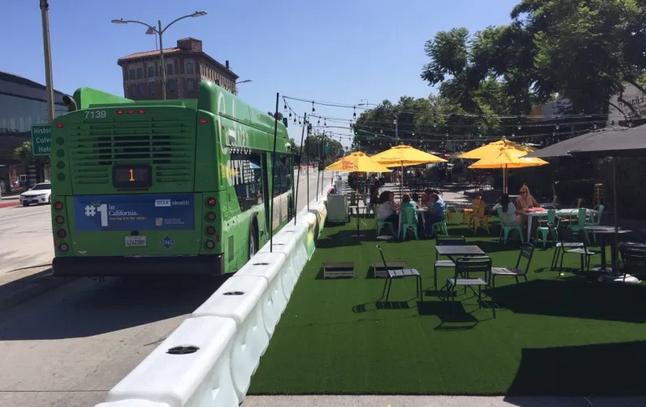Many southern California cities are responding to needs for restaurants and other businesses to shift operations outside under COVID-19. There are many examples including Glendale, Whittier, Downey, Burbank, Long Beach, Los Angeles, and more. One of the most worthwhile and ambitious examples is in downtown Culver City. On Culver Boulevard, the city used barricades to expand outdoor dining into the street and at the same time create a new dedicated bus lane.
The barriers are currently installed on the north side of Culver Boulevard extending about a third of a mile from Washington Boulevard to Duquesne Avenue. The city has also pedestrianized one adjacent block of Main Street, immediately north of Culver Blvd.
On Culver, a former parking lane and travel lane have been converted to space for walking and outdoor dining. Westbound traffic on Culver has been trimmed to a single bus/bike lane.
In July, the Culver City Council approved plans for quick-build "tactical mobility lanes" for buses, bicyclists, and emergency vehicles. The lanes are approved to remain in place for two years. The council approved a new open-air circulator bus that will operate between downtown and the Helms District, including connecting to the Culver City Metro E Line station.
We've already begun in Downtown Culver /3 pic.twitter.com/RUecLYWuu1
— Meghan Sahli-Wells (@M_Sahli_Wells) July 27, 2020
Longtime bike advocate Culver City councilmember Meghan Sahli-Wells describes the project:
These street “openings” (not closures!) were years in the making, even though this particular moment is so unique and challenging. It’s exciting. We have the smallest Main Street in the US, and it’s now the largest patio in Culver City! We’ve been able to weave together projects we’ve been discussing and planning for years – plans for a protected cycletrack from City Hall to the Metro [Expo Line] – plans to create dedicated bus lanes throughout the city – the Transit-Oriented Development Visioning study – the recently adopted Bicycle and Pedestrian Action Plan, etc. From planning to implementation, this immediate crisis has flipped the usual political script. Rather than the usual pushback to bold street transformations: “it’s too expensive,” “it takes away parking,” “it will make traffic worse,” all of a sudden these changes have become a public health and economic lifeline that businesses and residents eagerly embraced. In addition, our grassroots bike orgs have been great – Bike Culver City, Women on Bikes, etc.
From my point of view, the seeds were planted by CicLAvia - which, along with my direction (gonna give myself credit here), great work by Culver City staff and Metro grant funding - created a positive, collaborative and enthusiastic bond with the Downtown Business Association. This began with the very first Culver City CicLAvia hub in 2013.
Late last week, Streetsblog visited the site. The expanded curb space is allowing for needed distance for people walking and dining. Some drivers were using the bus lane. Some cyclists were using the sidewalk. But overall the new set-up appears to working well, attracting people downtown, while allowing them the space to walk and sit while observing healthy social distancing.






